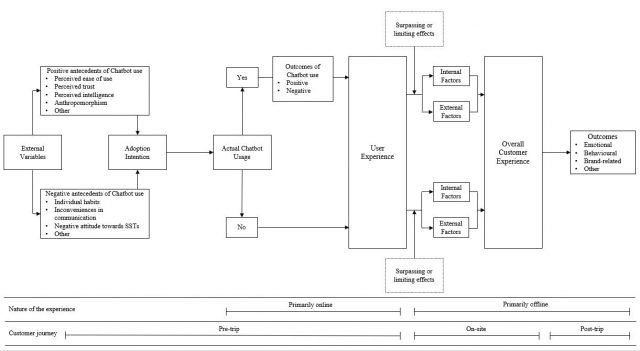How can a chatbot influence the customer experience of your tourism business?

With the constantly ongoing advancements of Industry 4.0, several interconnected developments can be seen affecting both the digital and operational environments of tourism businesses. These so-called Tourism 4.0 innovations refer to Industry 4.0 innovations (Big Data, Internet of Things, Blockchain, Artificial Intelligence etc.) that have been specifically refined to suit the needs of the tourism industry, ultimately bringing additional value to customers¹. To scratch the surface of this multidimensional phenomenon, this blog post will focus on technology-mediated communication tools, specifically chatbots, and their influences on customer experience.
Yet, we must notice the other side of the equation. In addition to addressing the influences of chatbots on customer experience, the issue will also be appraised from the perspective of Customer Experience Management (CEM). But first, as stated by Opute, Irene and Iwu², it is vital to define the concept of “customer experience” before addressing topics related to the leveraging of digital technologies. Thus, in order to fully comprehend the complexity of the topic, we first need to create a framework of understanding.
Understanding the fundamentals of customer experience
Customer experience is a common topic of interest in both general business research and tourism-specific research. Due to differences in industry-specific characteristics, it is vital to understand the difference between online customer experience and (overall) customer experience.
In their conceptual model of online customer experience, Rose, Clark, Samouel and Hair³ identify various antecedent variables affecting the Cognitive Experiential State (CES), as well as the Affective Experiential State (AES) of customers. While antecedents affecting CES are closely related to the concept of flow (e.g., interactive speed, online presence, challenge, and skill), antecedents influencing AES are often associated with individual perceptions of website functionality, aesthetics and assumed benefits. The above-noted Experiential States lead to the preferable outcomes of an online customer experience: (1) customer satisfaction; (2) trust; and (3) repurchase intentions.

Picture from Unsplash.com
Stankov’s and Gretzel’s¹ conceptualization addresses similar concepts in a different context. Their conceptualization showcases the role of Tourism 4.0 technologies in creating tourist experiences. Similarly, concepts related to the state of flow (i.e., object-oriented factors) are seen to have an effect on the user experience. Conversely, their Human-Centered Design (HCD) approach gives great emphasis to additional variables, specifically subject-oriented factors (e.g., previous experiences, behavioural patterns, and contextual differences). Ultimately, the aforementioned factors result in a subjective user experience. However, this is just a part of the full story. The main idea of the conceptualization is to illustrate the user experience as a mediator, supporting the formation of the overall tourist experience. In other words, a user experience is a tool creating either goal-surpassing or goal-limiting effects, which have an essential impact on the overall experience.
Hwang’s and Seo’s⁴ findings also emphasize the role of technology-mediated experiences as middlemen between the customer and the overall customer experience. Their conceptualization reviews the topic from a CEM perspective, thus giving greater emphasis to the characteristics and consequences of the overall customer experience. According to this broader description, the overall customer experience is shaped according to a set of internal factors (e.g., customer demographics) and external factors (e.g., online environment, technology, and service attributes). As a result, the overall customer experience revolves around aspects of co-creation, authenticity, transcendence, and transformation. What is the final outcome of the overall customer experience? Mentioned outcomes include emotional and behavioural outcomes, changes in brand perception, as well as other subjective outcomes.

Picture from Unsplash.com
Chatbots: What, How, Why & Why not?
What are chatbots?
Essentially, chatbots are auto-generated software having some sort of ability to interact with its user. This interaction can take place in the forms of audio or text⁵. These natural language-based dialogues between chatbots and users⁶ take place on multiple platforms, including company websites and mobile applications⁷, to name a few.
How do chatbots work?
Chatbots require certain prerequisites to function. At this point it is vital to understand the differences between the two most common chatbots of today – rule-based chatbots and AI-chatbots. Rule-based chatbots operate on a basis of set rules. These chatbots can only function within the framework of these set rules, which limits their functionality⁸.What happens when a rule-based chatbot is not able to process your request? Melian-Gonzalez, Gutierrez-Tano and Bulchand-Gidumal⁷ highlight the complementary relationship required between chatbots and humans. Consequently, when a chatbot is not able to process a piece of information, the request is transferred to a human (i.e., a customer service representative of a company). Another limiting factor is the inability to learn from previous interactions; rule-based chatbots cannot storage processed information into a knowledge base or a data storage⁸.
Conversely, AI-chatbots have the ability to utilize complex datasets and even predict customer behaviour (to a certain extent). These highly intellectual chatbots have a Natural Language Processing (NLP) layer, or they utilize an Artificial Intelligence Markup Language (AIML) to obtain and process customers’ textual and/or oral requests. Moreover, AI-chatbots are often associated with the concept of Machine Learning (ML). ML functions enable AI-chatbots to not only process customers’ requests, but also to make assumptions about customer behaviour and deliver suggestions accordingly⁹.

Picture from Unsplash.com
Why do customers choose or choose not to interact with chatbots?
In Pillai’s and Sivathan’s¹⁰ study, a total of 1480 Indian customers as well as 36 senior managers were surveyed to identify different antecedents of chatbot adoption. Their findings indicate that the main antecedents of chatbot adoption include perceived ease of use, perceived trust, perceived intelligence, and the human-like characteristics of the chatbot (anthropomorphism).
Conversely, a more recent study identifies several negative antecedents affecting the adoption intention (AIN) of chatbots. In the above-mentioned study, undergraduate students from two Spanish Universities were surveyed, obtaining a total of 476 valid responses. The findings imply that individual habits, such as previous use of chatbots, inconveniences in communication (i.e., having to adopt own language in order for the chatbot to understand), as well as having a negative general attitude towards Self-Service Technologies (SSTs) have a negative effect on adoption intention⁷.
Chatbots & customer experience: providing value or increasing frustration?
Chatbots contribute to the customer experience in various ways. A recent Malaysian case study, conducted in co-operation with Air Asia Berhad, analyses the influences of chatbots on customer experience. The study presents a variety of positive outcomes. Firstly, the ease of use is highlighted; utilizing a chatbot requires little or no technical competence. Secondly, the constructed AIRA chatbot is able to operate 24/7, providing immediate responses to customers’ queries. This notion was greatly emphasized, since prior to the case study, the service quality of the company was on an insufficient level¹¹.
The findings of Suanpang’s and Jamjuntr’s¹² case study add to the above-mentioned notions. During their study, an AI chatbot was constructed for tourists visiting the Active Beach Zone in Thailand. Their findings indicate the following: (1) chatbot usage minimized the cognitive overload of customers; and (2) chatbot usage contributed to overall customer satisfaction. A mention-worthy element adding to the overall customer satisfaction was the chatbots ability to provide personalized information and customized content.

Picture from Unsplash.com
Boiano’s, Borda’s, Gaia’s, Rossi’s and Cuomo’s¹³ case study addresses the opportunities presented by chatbots in the context of museums and heritage organisations. The results of their pilot project in Milan imply that chatbot usage increased the immersion of museum tours, encouraging younger customer segments to pay more attention to historic environments and objects.
Conversely, a vital element of experiences, co-creation, divides opinions among scholars. While Bowen and Morosan¹⁴ state that chatbots among other technical developments add to the co-creation of remarkable visitor experiences by efficiently utilizing customer data, other scholars recognize the disruptive elements of the same phenomenon. According to a statement, autonomous devices are seen to “dehumanize co-created experiences” because of their power of overtaking the responsibilities of human beings¹⁵.
Be ahead of the game: identifying future opportunities and threats of chatbots in tourism
By now you should understand the following topics:
-
-
- The fundamentals of customer experience
- The adoption, use, and functionality of chatbots
- How do chatbots influence the customer experience?
-
Adding to the understanding of these topics, a conceptual framework has been constructed.

Source: Author
What about the future of chatbots? What kind of opportunities and threats do you need to acknowledge as a manager?
One of the biggest mistakes you can make as a manager is to focus only on the more direct outcomes of chatbot usage. Chatbots can certainly minimize labour costs, create additional value for customers, as well as give you a competitive edge over your competitors. However, there are additional (indirect) focus points that you should consider.
Firstly, we must acknowledge that advancements in technology increase customer expectations. Consequently, you must consider how your chatbot can be developed to suit the changing needs of customers. Could you utilize Deep Learning practices or additional Application Programming Interfaces to train your chatbot? Do these training practices fit your budget?
Secondly, let us review the situation from an experience design perspective. As said, technology is just a mediator for the overall experience; the overall experience includes holistic and human-centred elements¹⁶. Still, as technology develops, Bowen and Morosan¹⁴ question whether it is the technology that primarily drives value creation. In other words, this would require rethinking the whole experience, since technology can provide more value to the client in the form of a better product, a lower price, or both.
Thirdly, we must address the threats of chatbot usage. The more apparent negative outcomes of chatbot usage include frustration and skepticism towards technology. Could this be affected by determining whether it is mandatory or voluntary for customers to use your chatbot? Furthermore, there is a future threat to consider. Researchers have questioned whether the trend of replacing the human labour force with chatbots will have negative influences on how customers perceive chatbots. This negative perception ultimately affects adoption intentions⁷.
Acknowledgements
This blog post was written as a part of the Information and Communication Technology in Tourism Business course at the International Master’s Degree Programme in Tourism Marketing and Management (University of Eastern Finland Business School). Read more about the programme at https://www.uef.fi/tmm
References:
¹Stankov, U., & Gretzel, U. 2020. Tourism 4.0 technologies and tourist experiences: a human-centered design perspective. Information Technology & Tourism, 22(3), 477-488.
²Opute, A. P., Irene, B. O., & Iwu, C. G. 2020. Tourism service and digital technologies: A value creation perspective. African Journal of Hospitality, Tourism and Leisure, 9(2), 1-18.
³Rose, S., Clark, M., Samouel, P., & Hair, N. 2012. Online customer experience in e-retailing: an empirical model of antecedents and outcomes. Journal of retailing, 88(2), 308-322.
⁴Hwang, J., & Seo, S. 2016. A critical review of research on customer experience management: Theoretical, methodological and cultural perspectives. International Journal of Contemporary Hospitality Management.
⁵Kumar, V. M., Keerthana, A., Madhumitha, M., Valliammai, S., & Vinithasri, V. 2016. Sanative chatbot for health seekers. International Journal Of Engineering And Computer Science, 5(03), 16022-16025.
⁶Dale, R. 2016. The return of the chatbots. Natural Language Engineering, 22(5), 811-817.
⁷Melián-González, S., Gutiérrez-Taño, D., & Bulchand-Gidumal, J. 2021. Predicting the intentions to use chatbots for travel and tourism. Current Issues in Tourism, 24(2), 192-210.
⁸Alotaibi, R., Ali, A., Alharthi, H., & Almehamdi, R. 2020. AI Chatbot for Tourist Recommendations: A Case Study in the City of Jeddah, Saudi Arabia. International Journal of Interactive Mobile Technologies, 14(19), 18-30.
⁹Calvaresi, D., Ibrahim, A., Calbimonte, J. P., Schegg, R., Fragniere, E., & Schumacher, M. 2021. The Evolution of Chatbots in Tourism: A Systematic Literature Review. Information and Communication Technologies in Tourism 2021, 3-16.
¹⁰Pillai, R., & Sivathanu, B. 2020. Adoption of AI-based chatbots for hospitality and tourism. International Journal of Contemporary Hospitality Management.
¹¹Kasinathan, V., Abd Wahab, M. H., Idrus, S. Z. S., Mustapha, A., & Yuen, K. Z. 2020. Aira chatbot for travel: case study of AirAsia. In Journal of Physics: Conference Series, 1529(2), 022101. IOP Publishing
¹²Suanpang, P., & Jamjuntr, P. 2021. A Chatbot Prototype by Deep Learning Supporting Tourism. Psychology and Education Journal, 58(4), 1902-1911.
¹³Boiano, S., Borda, A., Gaia, G., Rossi, S., & Cuomo, P. 2018. Chatbots and new audience opportunities for museums and heritage organisations. Electronic visualisation and the arts, 164-171.
¹⁴Bowen, J., & Morosan, C. 2018. Beware hospitality industry: the robots are coming. Worldwide Hospitality and Tourism Themes.
¹⁵Buhalis, D., Harwood, T., Bogicevic, V., Viglia, G., Beldona, S., & Hofacker, C. 2019. Technological disruptions in services: lessons from tourism and hospitality. Journal of Service Management.
¹⁶Tussyadiah, I. P. 2014. Toward a theoretical foundation for experience design in tourism. Journal of travel research, 53(5), 543-564.
- How can a chatbot influence the customer experience of your tourism business? - September 25, 2022